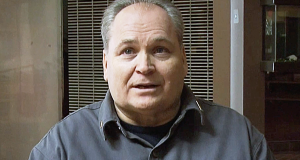 Looking like something out of a 1990’s science fiction movie, retired Air Force Captain and local athlete, Dean Juntunen showed his friends his latest achievement.
Looking like something out of a 1990’s science fiction movie, retired Air Force Captain and local athlete, Dean Juntunen showed his friends his latest achievement.
“So right now what I’m doing is strapping myself into this exoskeleton and I tell the robot to walk and then it starts stepping and it’s mindlessly stepping along. It’s more than I’m riding the robot than actually walking with it,” said Juntunen.

Juntunen is one of more than 160 veterans across the country who are taking part in a study held by the Veterans Administration. “Dean’s name is one of several that were given to us by the Spinal Cord Injury Service Chief Dr. Ken Lee at the Milwaukee VA. He was identified as someone who has been quite active since his injury and in good health. He’s done 91 marathons in his hand cycle,” said Joe Berman, who is the project manager of the Milwaukee, VA.

Learning to walk with the device has required many trips to Milwaukee for Dean. Yesterday that training came to the Copper Country and involved a few of his friends. Trainer Zachary Hodgson said, “Anyone who is using these devices at this time needs to have a companion to spot them when going over more difficult surfaces. Also, it just allows them and the user to have some ability to get out of the device in the case of an emergency.”
He has several of his friends on hand who are used to helping get him in and out of a kayak. “They’re getting a little bit of training to be my aid. They’re my back up,” said Juntunen
Juntunen sustained his injury in 1991 from a tree cutting accident resulting in a 30 foot fall. His upper body is still very functional and strong, as the 59 year old competes in athletic events regularly. “He has all of the muscles from his rib cage and up. Really with this device, it’s really good if someone can use all of their hands, if they’ve got really strong shoulders. His injury level allows that and allows him to be up in the device,” said Hodgson.

“I liken it to an enabled body person learning to walk with stilts,” Juntunen said. “If you’re walking on stilts you have to “learn to feel the ground” through that metal or wooden leg. That’s basically what I’m doing in the robot because I’m paralyzed from the chest down, so I have to “feel the ground” through the metallic robot leg.”
As he took a few steps through the Copper Country Mall, his friends were by his side learning how to assist if the device and Juntunen were to lose balance.
Hodgson said, “The training is going very well. Today is our first day out in the community and actually doing some in community training. It’s very telling. It’s very interesting going over different surfaces.”
“He’s on track to be bringing the device home,” said Berman.
 “Once he completes the program, Dean will have the option to choose one of these devices to take home with him and keep,” said Hodgson. “The goal of this entire study is to see how people use these devices in home and in the community and eventually get these devices to them.”
“Once he completes the program, Dean will have the option to choose one of these devices to take home with him and keep,” said Hodgson. “The goal of this entire study is to see how people use these devices in home and in the community and eventually get these devices to them.”
The exoskeleton is not perfect yet, and as the training progresses, the trainer makes programming adjustments to the machine, but Juntunen believes that this technology will quickly progress and will be a valuable resource for many. “It’s a very sophisticated technology on one hand, but on the other hand, I think it’s in its infancy and the robotics will probably develop very rapidly over the next 5 to 10 years,” he said.
 Keweenaw Report Your Source for Local News and Sports
Keweenaw Report Your Source for Local News and Sports





